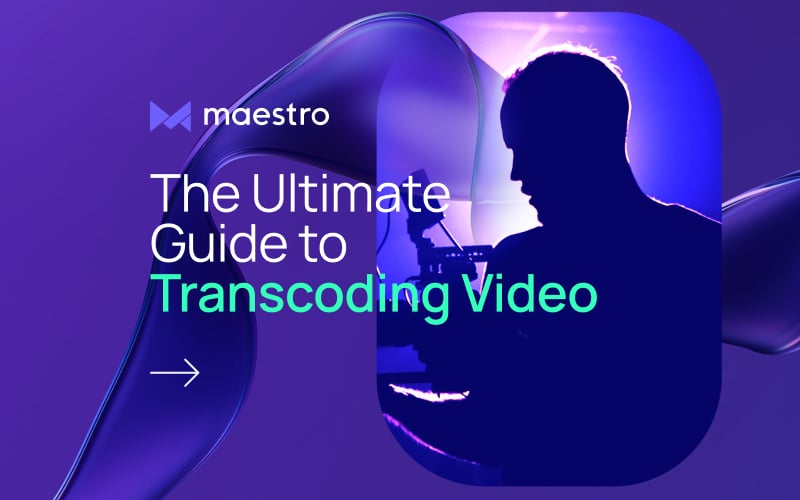The Ultimate Guide to Transcoding Video: How it Works & Why You Need It

Businesses and content creators are increasingly turning to live streaming to engage with their audiences.
If you’re leveraging live streaming for your business, you should know that the quality of your video streams is incredibly important if you want to achieve your digital content goals, whether that’s lead generation, customer retention, or simply monetizing live video.
In addition to elements like video resolution and bitrate, transcoding is a key factor in improving the quality of your streams.
In this comprehensive transcoding video guide, we’ll look at what transcoding is, how it can improve the viewing experience for your live streaming audience, and the best way to set up transcoding to get best results.
Table of Contents
- What is Transcoding?
- How Transcoding Works
- Benefits of Video Transcoding
- Transcoding Video Examples
- How to Choose a Transcoder
- Make Maestro Your Video Streaming Platform
What is Transcoding?

Transcoding is the conversion of one type of digital type media into another type. Generally, transcoding refers to taking an encoded media file and unencoding it in order to change its overall size or bitrate. Think of it as a way to dynamically change the video file for a live stream to maintain compatibility and quality with an individual viewer’s playback device and connection.
To understand why transcoding is important, we first need to talk about encoding and why that’s an essential step in the process of delivering a live stream. We’ll also talk about how transcoding plays a role in adaptive bitrate streaming (ABR) to make sure every viewer gets an optimal version of your live stream.
Transcoding vs. Encoding
Encoding is the process of compressing raw (and very large) media files into a format that can be transferred efficiently over the internet. It’s sort of like taking a giant tent and folding it up so that you can fit it into your car and take it to a friend’s house for their backyard barbecue.
So, what would transcoding look like in this example? Well, transcoding is all about changing the size of the file after it’s already encoded – essentially, you would encode the file, alter it in some way, and then re-encode it again.
So, in this tent delivery example, say that when you arrive at your friend’s house, you realize the table doesn’t fit through their backyard gate. But by unfolding the tent again and then refolding it more tightly, you’re able to make the tent small enough to get through the gate.
As we’ll discuss, this transcoding effort is helpful for ensuring quality and compatibility with more users, rather than having to rely on a “one-size-fits-all” video file and its settings.
Transcoding vs. Transmuxing
Another related term is transmuxing, which is a similar but distinct process to transcoding. With transmuxing, you’re able to quickly adapt content to different streaming protocols without needing to re-encode first.
By contrast, transcoding has the additional step of unencoding a file and changing the contents rather than altering the packaging alone. In practice, either method has the benefit of making your video accessible to more viewers – but we’ll focus on transcoding in this article.
How Transcoding Works
Transcoding consists of a few specific steps in converting a video file from one format to another. It takes place using a transcoder, which is usually included in a streaming server or a cloud-based streaming platform, in order to suit the delivery requirements for each viewer.
A transcoding video workflow includes:
- Analyzing Input File: The transcoder will analyze the input file to come up with technical settings like format, codec, resolution, and bitrate
- Decoding the Contents: The transcoder breaks down the file into its raw audio and video components
- Processing the Raw Video: The transcoder will adjust the raw video based on what’s needed, potentially including the resolution, aspect ratio, bitrate, or frame rate
- Re-encoding the File: The transcoder will re-encode the video in the target content format
- Generating Output File: The transcoder will wrap the file in a new container format that works for each of your viewer’s required specifications based on their playback device and network connection
Types of Video Transcoding
Aside from the process of transcoding, you should be aware of the three primary types of video transcoding. These include:
- Lossy to Lossy: The data is compressed using lossy compression, then is uncompressed and recompressed further via transcoding. This results in lower video quality.
- Lossless to Lossless: The data is compressed using lossless compression, which means no information is lost when uncompressed and compressed once again in the same format.
- Lossless to Lossy: The data is compressed with lossless compression, so no information was lost initially, but after uncompressing and recompressing, some information loss occurs.
You’ll want to understand the differences here because the amount and type of compression can reduce file sizes, but at the expense of overall video quality due to loss of information. Note that any discarded data can't be recovered once a file has been compressed through lossy compression.
Benefits of Video Transcoding

Hopefully, it’s clear now why transcoding is an essential feature for any live stream. Perhaps most important is the way it supports adaptive bitrate streaming to build out a wide range of different versions of media files for your video stream, which allows you to cater the bandwidths and devices of every end user.
With that in mind, here are a few other benefits of video transcoding.
Widen Your Audience
Transcoding allows you to widen your audience and attract more viewers because it can make your stream to be compatible with all playback devices you want to reach. This includes everything from computers to smart TVs to mobile devices.
Support Different Internet Connections
Similarly, by providing your video in a range of bitrates and resolutions, you ensure that bandwidth isn’t an obstacle for people to enjoy your content. No matter what bandwidth a user has, they can still engage with your stream, as opposed to just people with the best internet connections.
Optimize the Viewing Experience
Lastly, and most importantly, you can optimize the viewing experience for every individual viewer, providing the highest video resolution for a viewer that you can without resulting lag or buffering.
Transcoding Video Examples
Let’s walk through a few real-world examples of transcoding video use cases to paint a picture of how it can make an actual difference for businesses.
1. International Business Conference
Imagine that a multinational corporation will host a global conference with participants tuning in from all over the world. Because these users are all accessing the live stream from different locations, their distance from the source and overall internet bandwidth will vary greatly.
With transcoding, multiple versions of the live stream can be created in a range of resolutions and bitrates, ensuring everyone on the stream can enjoy the highest-resolution version without sacrificing playback smoothness.
2. Product Launch Demonstration
Imagine a technology company is launching a new product via live stream with a sizable audience accessing their stream to see the product in all its glory.
With transcoding, this company could have a high-definition stream for desktop viewers and a lower-resolution stream for mobile viewers. This makes it possible for the company to reach a wider audience and make the best possible impression in showcasing the new product’s features.
3. Live Fitness Coaching Session
Imagine a fitness coach decides to broadcast a live, interactive workout session for his audience. Some of this coach’s audience is likely less tech-savvy, so viewers will access the stream on a wide range of devices, from laptops to mobile devices to smart TVs.
With transcoding, viewers with high-speed internet and fast devices can follow the coach’s live workout in full HD, while viewers with a slower connection can still see the stream at a lower resolution with a buffer-free experience.
How to Choose a Transcoder

Choosing a transcoder starts with being aware of your typical viewer. If you know what kind of device and bandwidth your ideal viewer usually has, you can figure out the range of formats, resolutions, and bitrates you need to support!
You should also consider whether you’ll opt for a cloud-based solution or a local transcoder. The cloud-based solution is more scalable and doesn’t require as much of an upfront investment as a hardware option.
Your overall streaming workflow is unique to you, so you’ll have to decide which transcoder will integrate best.
With Maestro, we work with different streaming providers that offer transcoding. Mux is our default provider, but we also integrate seamlessly with Amazon IVS, Dolby.io, Brightcove, and more.
Of course, before you go live with any transcoder in your workflow, it’s important to test it and ensure it works how you expect it to. This ensures you won’t damage your reputation with a poor experience for your audience.
Make Maestro Your Live Streaming Platform

Whatever transcoder you use for your live streams, we hope you’ll consider Maestro as your online video host of choice. Maestro’s streaming platform lets you live stream without confusion or limits.
Maestro offers an end-to-end video CMS for hosting, monetizing, and delivering your streaming experiences. Plus, with our drag-and-drop website builder, you can set up a professional-looking streaming website with a few clicks. Choose your branding, add monetization, and go live in just minutes!
Sign up today to host exclusive streams for your audience in no time at all.
Join our Discord server to learn more tips and tricks for streaming on Maestro.